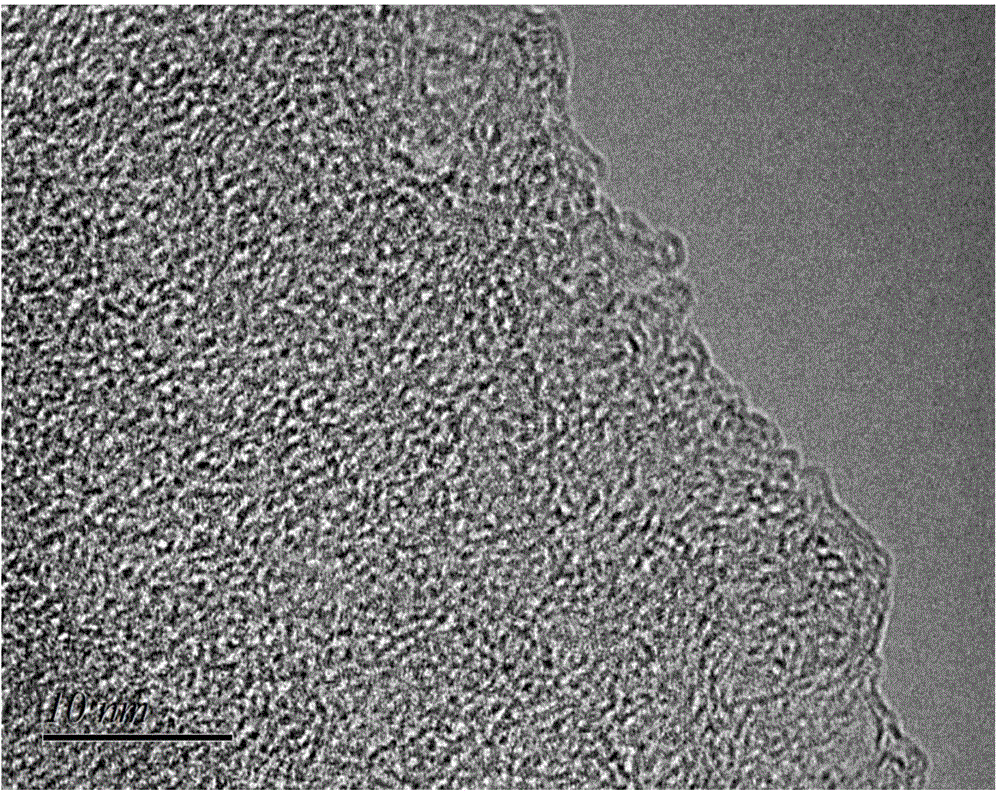Carbon material for lithium ion battery negative electrode and preparation method for carbon material, lithium ion battery negative electrode and lithium ion battery
A lithium-ion battery and carbon material technology, applied in battery electrodes, circuits, electrical components, etc., can solve the problems of not fully exploiting the utilization value of coal liquefaction residues, and achieve the effects of low cost, simple process, and high purity
- Summary
- Abstract
- Description
- Claims
- Application Information
AI Technical Summary
Problems solved by technology
Method used
Image
Examples
preparation example Construction
[0025] As mentioned above, the present invention provides a method for preparing a carbon material for negative electrodes of lithium-ion batteries, the method comprising: polymerizing coal liquefaction residue; stabilizing the polymerized product, and carbonizing the stabilized product.
[0026] The method of the present invention adopts coal direct liquefaction residue as raw material, uses thermal polymerization method, does not need catalyst, prepares negative electrode carbon material of lithium ion battery through polymerization, stabilization and carbonization, on the one hand saves the use of catalyst, on the other hand also The separation process after polymerization and the organic solvent or precipitant required for separation are omitted.
[0027] According to the method of the present invention, the preferred polymerization conditions include: the temperature is 380-440°C, preferably 390-420°C. The performance of the carbon material synthesized in this way for the...
Embodiment 1
[0050] Coal liquefaction residue (containing 20% by weight of ash, produced by direct liquefaction of Shenhua Group coal, and the rest of the examples are the same) was purified (to obtain coal liquefaction pitch, containing 91.19% by weight of carbon, 5.65% by weight of hydrogen, average molecular weight of 500, softened The temperature is 150°C, the ash content is less than 200ppm, and the rest of the examples are the same), after crushing (particle size is <5mm), put it into a polymerization reactor for polymerization, the polymerization temperature is 400°C, and the time is 8h;
[0051] Crush the polymer product, grind it finely in an agate mortar, sieve it with a 0.5 mm sieve to obtain a polymer product below 0.5 mm, weigh 50 g and spread it on a tray, place it in a stabilizing furnace, let in air, adjust The flow rate is 4m 3 / h, after heating to 240°C, keep the temperature for 10h;
[0052] Ball mill and sieve the stabilized product to obtain a stabilized product bel...
Embodiment 2
[0055] Purify the coal liquefaction residue, crush it (particle size <5mm) and put it into a polymerization reactor for polymerization. The polymerization temperature is 390°C and the time is 9 hours;
[0056] The polymerized product is crushed, ground in an agate mortar, sieved with a 0.5mm sieve to obtain a polymerized product below 0.5mm, weighed 50g and placed on a tray, placed in a stabilizing furnace, and fed with air. Adjust the flow rate to 4m 3 / h, after heating to 240°C, keep the temperature for 10h;
[0057] Ball mill and sieve the stabilized product to obtain a stabilized product below 0.1mm, weigh 10g for carbonization, use high-purity argon for protection during carbonization, raise the temperature to 300°C at a constant temperature of 1h at a heating rate of 5°C / min, and then continue to This rate is heated up to 1000 ℃, constant temperature 8h, obtains carbon material (the basic performance of this material is basically consistent with the material of embodime...
PUM
| Property | Measurement | Unit |
|---|---|---|
| particle size | aaaaa | aaaaa |
| softening point | aaaaa | aaaaa |
| softening point | aaaaa | aaaaa |
Abstract
Description
Claims
Application Information
 Login to View More
Login to View More - R&D
- Intellectual Property
- Life Sciences
- Materials
- Tech Scout
- Unparalleled Data Quality
- Higher Quality Content
- 60% Fewer Hallucinations
Browse by: Latest US Patents, China's latest patents, Technical Efficacy Thesaurus, Application Domain, Technology Topic, Popular Technical Reports.
© 2025 PatSnap. All rights reserved.Legal|Privacy policy|Modern Slavery Act Transparency Statement|Sitemap|About US| Contact US: help@patsnap.com


